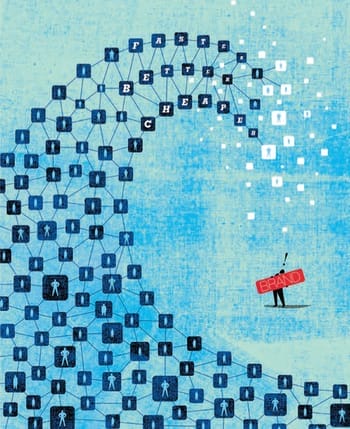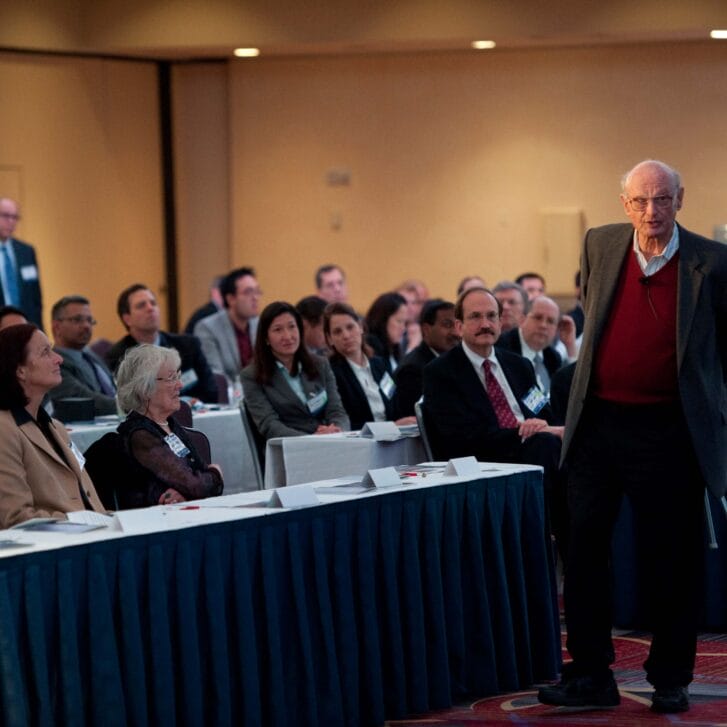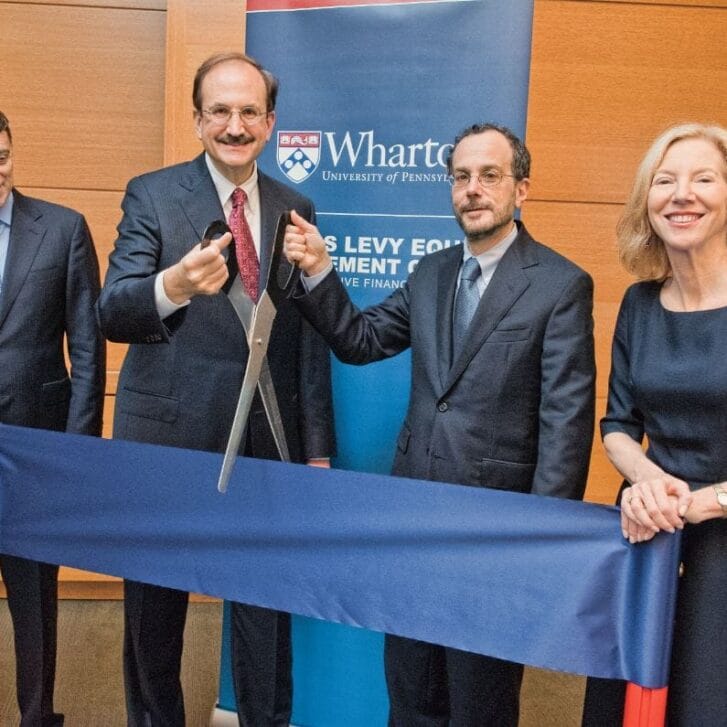Last spring, the Ford Motor Company introduced a new version of its fuel-efficient, two-door compact model, the Fiesta.
It was an important launch for Ford, an opportunity to reverse the company’s public image as an out-of-touch builder of gas-guzzling SUVs and appeal to younger, more eco-conscious drivers. But instead of hiring an ad agency to carry out the marketing campaign, the car maker launched something called the “Ford Fiesta Mission,” loaning Fiestas to 100 Web-savvy drivers who would test the car for six months and chronicle their experience on sites like YouTube and Twitter. In essence, Ford handed over the role of marketing—and, more remarkably, actually ceded brand control—to consumers.
“That’s the future,” says Yoram “Jerry” Wind, Wharton’s Lauder Professor and director of the SEI Center for Advanced Studies in Management. “The agents are connected to large social networks. They have credibility; Ford doesn’t have credibility.”
Wind has been doing a lot of forward thinking on the subject of marketing. He’s director of the SEI Center’s “Future of Advertising Project,” an attempt to understand the rapid changes currently taking place in the ad world, including the digitization of media and the fact that consumers, with more options and easy access to information, are more empowered than ever before. The project’s goal, says Wind, is nothing short of “reinventing the scope, practice and value of advertising” for the 21st century. To do this, Wind, along with co-director Catharine Findeisen Hays, has assembled a board of influential industry leaders and academics, and partnered with Google to create a YouTube channel (www. youtube.com/fastforward) with video content that explores new approaches to marketing and advertising.
According to Hays, one of the central challenges facing the industry is how to best reach consumers in an age of media fragmentation. “It’s gone from TV, radio, print and direct mail to almost an unlimited set of options,” she says. For both brands and advertising agencies, the numerous avenues to reach potential consumers are thrilling but also potentially paralyzing. Do they buy TV spots and run a traditional commercial? A print ad? Advertise on the Web? If so, where? Through Google? On a popular blog? By creating viral videos on YouTube? By launching a social media campaign on Facebook or MySpace or Twitter?
“That’s the $300 million question,” said Andrew Essex, CEO of the new York ad agency Droga5. The vast amount of media choices, with more options created every day, has created an almost existential dilemma within the industry. “There are millions and millions of sites online,” Essex says. “Can you actually communicate or control a conversation with that much abundance?”
Jon Greenwood, WG’03, currently the corporate VP of global operations at 24/7 Real Media, a digital media marketing company, agrees. “I think people are just starting to figure out how to leverage these new platforms,” Greenwood says. “It’s not the same as dropping a banner ad on Yahoo. Brands are leery of jumping in feet-first.” Greenwood cited the fact that, although Facebook is a media sensation with over 200 million users, social media currently accounts for just five percent of digital spending. “The majority is still going to search,” he says.
The economic crisis has complicated matters by making ad dollars scarce—and creating pressure on agencies to get the most bang for a company’s buck—at a time when the ground is shifting below everyone’s feet. “There’s confusion, frustration and uncertainty right now in the ad world,” Wind says. “These feelings are a culmination of forces that started before the crisis, but the downturn brought things to a head.”
According to Hays, this is a time when companies and agencies should try new ideas, even if it requires an outlay of cash. “With things happening so fast, if you’re not experimenting, how do you keep up with it all?” she says, adding that once companies adopt that mindset, they’ll be comfortable spending money and even failing at first. But, Hays adds: “We’re only going to feel okay about stumbling if we have a plan for how we stumble.”
The Empowered Consumer
One of the biggest issues the Future of Advertising Project is tackling is how to deal with a more empowered consumer. Television viewers are no longer forced to sit through commercials. Using on Demand or DVR, they can zip right by them. A Google search, meanwhile, returns ratings from countless independent sources for just about any conceivable product.
This interactivity has revolutionized the messaging game, and has made a particular impact on the travel industry. “Look at Priceline.com,” says Wind. “As opposed to an airline or hotel deciding what to charge, the consumer decides the price they want to pay and makes an offer.”
Some brands have panicked at the lack of control, or, worse, have tried to control the message surreptitiously, dispatching representatives to pose as consumers online. It’s a risky move.
“The world is more transparent now,” says Chuck Porter, a partner in the global advertising firm Crispin-Porter + Bogusky and a member of the Future of Advertising Advisory Board. “You can’t hide online.”
Some forward-thinking companies, by contrast, have embraced the new interactivity. Ford’s “Ford Fiesta Mission” is one prime example; so is Nike’s recent initiative to let runners design their own shoes. The company for the past two years has also hosted the “human race,” an event that offers customers a chance to meet and run together. “They’re not customers, they’re Nike participants,” Hays says.
No More ‘Hunting’
Drawing such a distinction suggests a seamless integration of advertising into one’s personal experience; it’s no longer about a company talking at a consumer through an ad, but an ongoing two-way dialogue, facilitated by the internet and other channels.
As a result, brands and agencies are analyzing every “touch point” between the consumer and the product—from packaging and design to the retail store experience to the company website. “Before it was simply, ‘Let me buy some TV advertising and run an ad,’” to reach the target customer, says Wind. “But the idea of a target is wrong; it suggests that I’m the ‘hunter.’ We’re dealing with cynical, skeptical consumers.”
Scrutinizing every facet of a company’s operation—a process that is increasingly being overseen by ad agencies—can ideally lead to a richer consumer experience and even higher-quality goods and services; after all, consumers don’t want to incorporate an inferior product into their life. And they aren’t interested in lame marketing efforts, either. “You used to be able to buy relevance,” with a flood-the-zone advertising campaign, says Essex. “Idiotic and lame ideas are increasingly fallible.”
As an example of the kind of sophisticated, new-model thinking being studied in the “Future” project, Hays cited a campaign for Samsung devised by Stoic, an agency in Denmark. Using a behavioral science approach, the agency analyzed the big-screen TV shopping experience for women. In so doing, they realized most women need to think about big purchases before committing. the agency arranged for female shoppers to be given a coupon for a free coffee at a coffee house near the appliance store. The idea paid off: Instead of going home, where they were more apt to change their mind, the women with the coupons grabbed a cup of coffee and extended their shopping day, thereby increasing the chance they would return to the store.
Oh, one more small detail: On the wall of the coffee house hung a Samsung TV.
“Rather than saying, ‘What kinds of ads should we do?,’ they took a step back and looked at the journey,” Hays says. “In so doing, they reinvented the way female buyers in Denmark relate to Samsung.”
At Crispin-Porter + Bogusky, the Internet is increasingly the preferred medium for reaching consumers. Five years ago, the 1,000-employee agency had two digital specialists producing online content. Today, the agency has 270, and the campaigns Porter talks about most enthusiastically are those that leverage the firm’s newfound technological capabilities. Working with Burger King, the agency devised the “Whopper Sacrifice,” a cheeky campaign where anyone who dumped 10 friends on Facebook got a free whopper (though the campaign generated enormous buzz when launched early last January, it was eventually pulled when Facebook objected). “The thing about interactive is that it’s interactive,” Porter says. “The way we think about things is to engage people.”
 Power of the People
Power of the People
Another new concept popping up at ad agencies is the use of “crowd-sourced” content. XLntads, a company based in Wynnewood, PA, has created a social network of commercial videographers called Poptent.
When the firm is hired—its current clients include Snickers and Calloway golf— they send out a general call to their network for content related to the campaign. “We get back 100, sometimes 125 videos,” says Mark Schoneveld, Senior Community Manager for Poptent, “and the agency or client can choose the ones they want.” Admittedly, Schoneveld says, up to half of the submissions are amateurish or otherwise unusable, but many are clever, professional—and cheap. “The creators get paid about $5,000 for their spot,” he says. “An agency would normally pay in the six figures.”
Adds Tony Romeo, GrW’73, a former economics professor who now serves as Poptent’s senior vice president: “Our argument is the old model doesn’t work anymore. Spending $400,000 every time you need a new video strains a company’s marketing budget.”
Like many others in the industry, Porter believes the decades-old, tried-and-true methods of advertising will not be completely abandoned in the transition to a digital world. “The cheapest way to reach a lot of people is still to buy a TV commercial,” he said. Yet he says the web’s ability to track consumers and precisely measure the success of an advertisement is highly appealing. “Online,” he says, “you can measure everything.”
Hays agrees. “There’s a sense that online is much more measurable than off-line,” she said. “You can [know] that seven out of 10 people clicked on the banner ad. You track it. A taste for that level of specificity is seductive.”
The sophisticated consumer behavior data google and other companies are collecting based on our Web searches and the sites we visit is creating a world in which consumers will see ads tailored specifically to them. “In the past, the assumption was you and 72 million other people are watching the Super Bowl,” Essex says. “It’s one swath of people with the same interests. Now we know what you buy, listen to, read. We can create targeted messages that reflect those sensibilities.”
And with the explosion of technology, particularly more powerful mobile devices, those messages can be beamed directly to your homepage or your phone. The upside, experts say, is efficiency—for both the consumer and the brand. “I don’t have a lot of extra time, so I don’t want to see ads for products i don’t care about,” Hays says. “And companies don’t want to market to me if I don’t want, say, musky-smelling cologne.”
Asked where he thinks advertising is heading in the next few years, Porter was not surprisingly most excited about analytics (“Specific data analytics will become more important, because you can get them,” he says), but he is cautious about getting wrapped up in “future” talk. At the end of the day, he says, advertising is the same game it’s always been. It’s just that the rules of play have changed.
“We’re not really futurists,” he says.
“We’ve always just focused on doing something smart, today, for this client, this morning. There’s a very fundamental change happening in the way people get their information and entertainment. But I don’t think there’s a fundamental change in what brand messaging works. We create stories for brands; that hasn’t changed since I entered the business.”
Steven Kurutz is a staff reporter for the Wall Street Journal. His last story for Wharton Magazine, “A Dizzying Downturn,” appeared in the Fall 2009 issue.


























